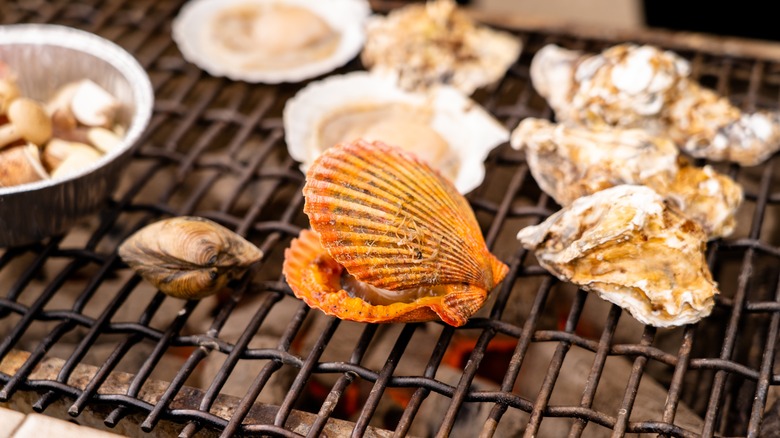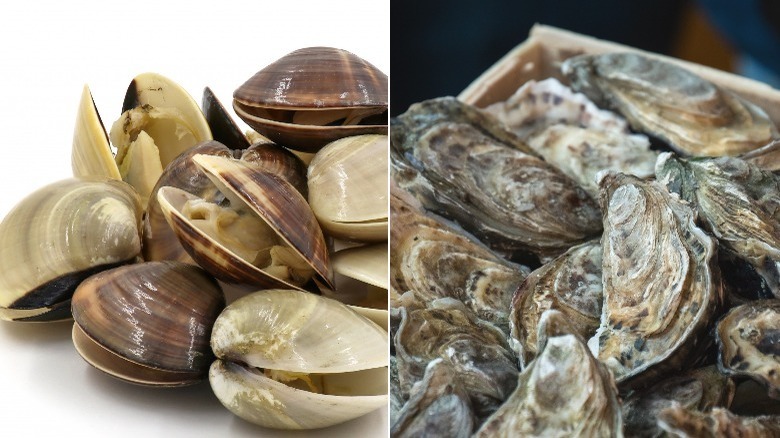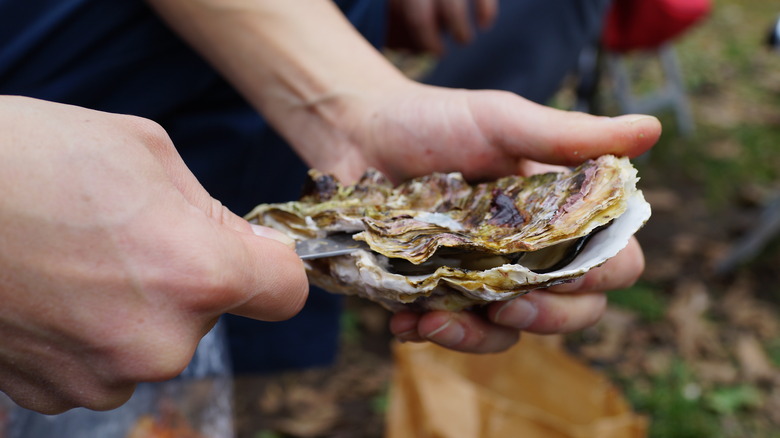What's The Difference Between Oysters And Clams?
If you are an avid devourer of bivalves, you can likely rattle off the differences between a clam and an oyster faster than the RoadRunner can foil Wile E. Coyote. Many people, however, are not quite so shellfish-literate and need a little help simply telling these two mollusks apart.
After all, not every American partakes in either clams or oysters regularly. While Insider reveals that in 1900, New York City consumed roughly a million oysters each day, this is far from the case today. For one thing, they are no longer considered the cheap dish they were then. As food author Kathleen Fitzgerald told Boston.com, "They weren't just the way we eat them now as a special treat" — they were abundant (at least until overfishing and environmental factors had their way). Admittedly, the clam does fare a bit better in modern times, clinching the tenth spot on Intrafish's list of the top 10 seafood species eaten by Americans in 2018, but the average person still only eats .32 pounds annually. That's not a lot of clam chowder.
Clearly, Americans are much less familiar with bivalves than, say, beef. If you'd like to gain a degree of mastery over these mollusks, however, it's important to understand how they differ from one another.
Clams and oysters have very different looks and lifestyles
If you were to hold a clam and an oyster side-by-side, you'd likely be surprised by how easy it is to tell them apart. Ocean Conservancy explains that clams live in "stout, oval-shaped" shells with smooth surfaces. The bottom and top halves are the same shape and size, making them the more symmetrical of the two bivalves. Oysters, on the other hand, have bumpier surfaces and widely varied shapes. If you were to judge a mollusk completely by its cover, the shinier clam would reign supreme.
The clam and the oyster, according to Foodstruct, also lead very different lives. Unlike its "rougher around the edges" relation, the clam lives more often in freshwater places, using its "muscle foot" to dig itself a hiding spot in the sand. The oyster uses its short-lived muscle foot to find a rock to latch onto as it carves out its existence in a saltwater environment, but after that, it doesn't move much. While the clam appears to hide, making it more difficult to find, the oyster stays in shallow areas, enabling it to be more easily spotted. Yes, you will have to work a bit harder to gather the ingredients for a batch of linguine and clams than a helping of oyster stuffing.
Clams and oysters require unique shucking skills
When it comes to shucking these bivalve relations, there are stark differences. The idea behind opening a clam is to use a knife to separate the top and bottom of the shell. When dislodging an oyster, meanwhile, you must "push ... through the back of the shell" — as a result, SF Gate says the knives designed for each task are quite different and not usually interchangeable. Oyster knives have a modest point and beveled edges, and are "shorter, broader, and squatter." Clam knives, on the other hand, boast a rounder tip on a long and slender blade.
The rewards of knowing the difference between these creatures — and the tools required to consume them — are plentiful. Once your shellfish are ready for eating, you will be treated to a healthy offering of vitamins and minerals. Both boast a significant amount of protein and many times the daily value of vitamin B12, and they are also relatively low in calories and fat compared to other sources of protein. Clams offer a larger dose of iron, vitamin C, and other minerals, notes Men's Health, while Livestrong reveals that oysters are richer in copper, selenium, and zinc.
Flavor-wise, Seafood University says that clams might be a bit saltier, with oysters tasting more delicate. But no matter which nutrient or flavor you pursue, you are now fully versed in spotting your favorite mollusk: where to find it, how to open it, and what nutritional value it offers. Let the shucking begin.


